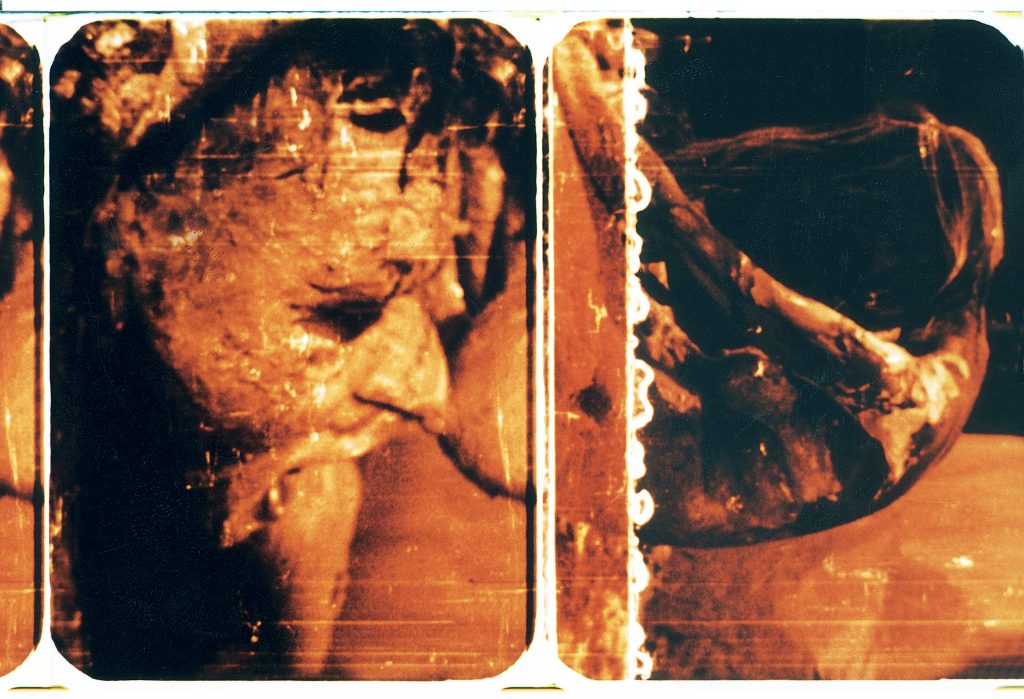Q Kurt KREN, Lord of the Frames
16works 61min
Theatre Image Forum(TOKYO):8/7 21:15
Spiral Hall(TOKYO):8/10 16:20
Lumen Gallery(KYOTO):8/26 16:15
Aichi Arts Center(NAGOYA):9/27 19:00

Kurt Kren – Lord of the Frames (1929 – 1998)
Kurt Kren first received the honorary title ‘Lord of the Frames’ from an article of the same name by Peter Tscherkassky on the occasion of his first major exhibition at the Vienna Secession in 1996. It was only in the 1990s and after his untimely death that he received international recognition. As the son of a Jewish father Kurt Kren was one of those children who were brought to Holland in 1938 to escape National Socialism. In Rotterdam he experienced the nationwide bombing. In the early 1950s Kren began to experiment with 8mm film and had a secure job with the Austrian National Bank. He used to go to the artists’ studios’ Strohkoffer ‘and’ Art Club ‘, where he met colleagues like Ferry Radax, Marc Adrian and Peter Weibel, as well as the writers of the Vienna group. In 1957 he created his first 16mm film, which was also the first work of his numbered filmography. There are some films with serial montage technique and he anticipates together with Peter Kubelka the later designated in the US as a “structural film” direction by years ahead. He worked on precise graphs on graph paper, designed the films directly in the camera, and Kren’s structuring reached a maximum of mathematical rigor and precision.
Only the cooperation with the Viennese actionists Otto Mühl and Günter Brus in the years 1964 – 1966 led to a radicalization of his form and aesthetics. The consequence was media scandals and the loss of his job at the bank. Even Otto Mühl did not want his actions to be fragmented and fragmented by Kurt Kren, but sought a brave documentarist. Kren found his own rhythm as the action spun, literally danced around the actors and for the first time used his now famous shortcut method, which was mostly created using frame by frame. Remarkable about Kren’s action film is that he had left nothing of the theatrical dramaturgy of the performances left, the body actions were compressed and fragmented beyond a temporal sequence. Nevertheless, these action films form a unique cinema of intensity and some of the most important body performances created especially for the film.
Kurt Kren emigrated to Germany, because he hoped there a wider recognition. “One center was Karl-Heinz Hein’s Progressive Art Production (PAP) in Munich, a distributor of European and American underground films, another XSCREEN, Germany’s first underground cinema theater, the filmmakers Wilhelm (the brother of Karl-Hein) and Birgit Hein 1968 in Cologne”. Kren lived with her for a long time, from which the film An W + B was filmed out of her window. He was also able to find shelter with the curator Hans-Peter Kochenrath and created the landscape masterpiece 31/75 Asyl in the wooded surroundings. Even then, American and English filmmakers such as Ernie Gehr, Stephen Dwoskin, and Malcolm LeGrice discovered him and worshiped him as a model of their own artistic paths.
But life with fellow artist colleagues could not last and he went to the late 1970s to America, where he had to keep afloat as a day laborer and finally as a museum guard at the Museum of Fine Arts in Houston. Kren himself called the films that he made during his time in the US “bad home movies” because they reflected and depicted his time in exile (personally and artistically, he had no time for sophisticated cinematic concepts).
In 1989, Hans Scheugl, VALIE EXPORT and the then head of the film department in the Ministry of Arts Kurt Kren returned to Vienna to organize community housing and a boarding house. He quickly integrated himself back into the domestic film scene and came to many events. He was the first of us all who had internet and e-mail. In this security he could still realize some big movies like 49/95 Thousand Years of Cinema. For this, he photographed the snapping and filming tourists with his Bolex for six weeks and created a dance-like and ironic study of the rituals around a landmark.
In addition to the formal intensity, there is also a “documentary” dimension in Kren’s films. He created timeless and sometimes touching works from fleeting, everyday moments. These events of the real world turned into impressive, silent condensations of space and time.
1/57 Experiment with Synthetic Sound Kurt KREN / 16mm / 2min. / 1957
2/60 48 Heads from the Szondi-Test Kurt KREN / 16mm / 4min. / 1960
3/60 Trees in Autumn Kurt KREN / 16mm / 5min. / 1960
6/64 Mama and Papa Kurt KREN / 16mm / 4min. / 1964
8/64 Ana – Action Brus Kurt KREN / 16mm / 3min. / 1964
9/64 O Christmas Tree Kurt KREN / 16mm / 3min. / 1964
11/65 Helga Philipp Painting Kurt KREN / 16mm / 2min. / 1965
15/67 TV Kurt KREN / 16mm / 4min. / 1967
31/75 Asylum Kurt KREN / 16mm / 8min. / 1975
32/76 To W+B Kurt KREN / 16mm / 7min. / 1976
33/77 No Danube Kurt KREN / 16mm / 8min. / 1977
37/78 Tree Again Kurt KREN / 16mm / 3min. / 1978
42/83 No Film Kurt KREN / 16mm / 1min. / 1983
44/85 Foot’-age shoot’out Kurt KREN / 16mm / 3min. / 1985
46/90 Falter 2 Kurt KREN / 35mm / 1min. / 1990
49/95 thousandyearsofcinema Kurt KREN / 16mm / 3min. / 1995
※All digital / Austria

